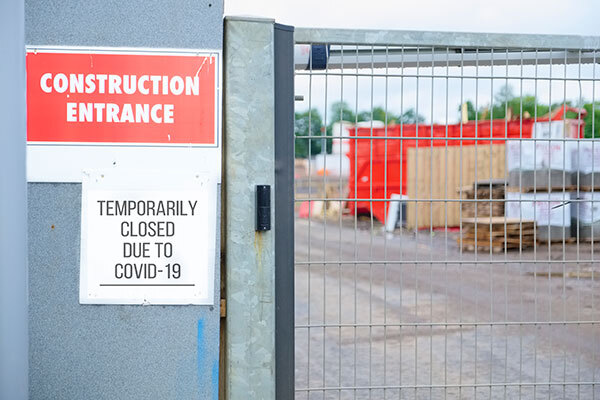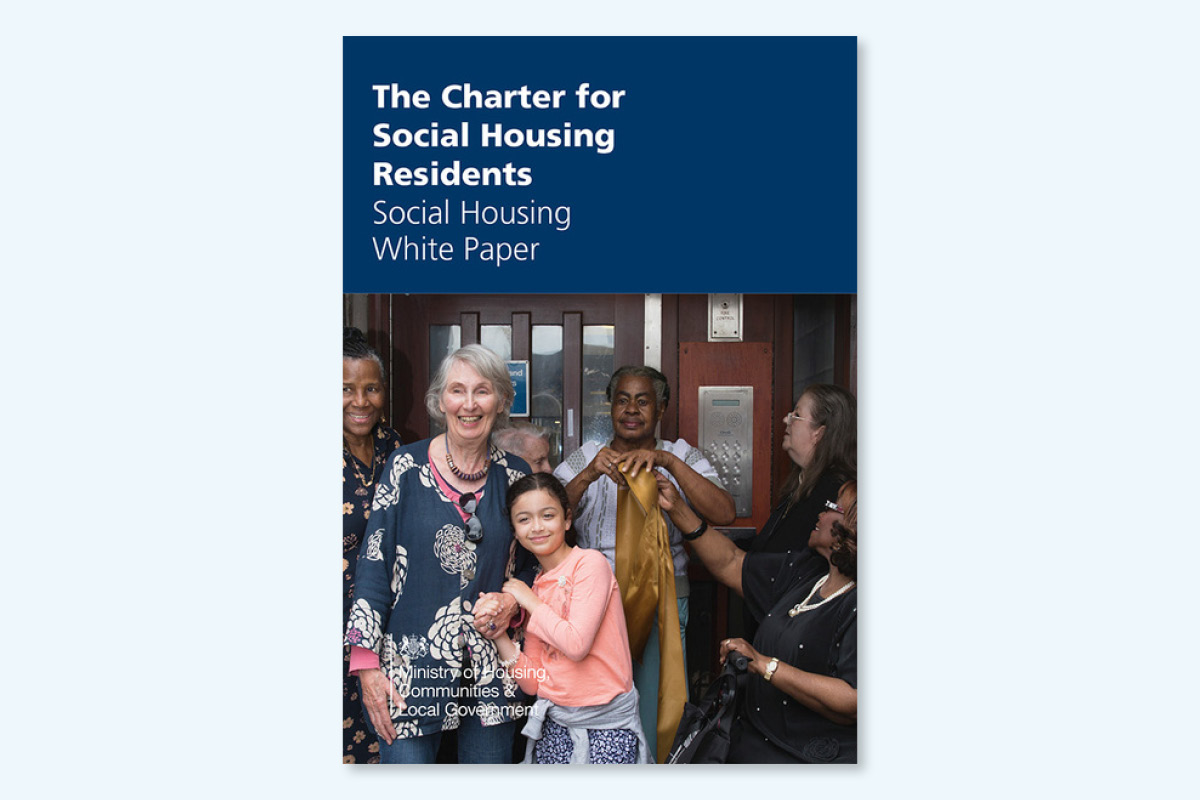You are viewing 1 of your 1 free articles
A look at the year ahead: the big issues for housing in 2021
The next 12 months promise to be important in the recovery of the housing sector following the pandemic that consumed much of 2020. Here, the Inside Housing news team takes a look across the sector at the big issues or trends to look out for in 2021. Illustration by Nate Kitch
The past 12 months have been some of the most unusual in recent history, with the coronavirus pandemic affecting every facet of daily life. The next year is expected to see coronavirus once again dominate the headlines but with a vaccine roll-out under way, there is a glimmer of hope for normality to return.
So with that in mind, the Inside Housing news team looks ahead to 2021.
Brexit
When the clock struck one minute past midnight on 1 January, the UK entered a new phase in its history. The country was no longer part of the EU. While a deal agreed at the eleventh hour was welcomed by most, there are still significant changes that will impact many parts of daily life this year, and the housing sector is not immune.
The primary concerns for associations and councils will be the impact of Brexit on the economy and trade, and how that could effect development and the housing market. If the economy drops further this year as a result of Brexit, the housing market is likely to follow, which is worrying for associations, particularly in the big cities, that rely on the cross-subsidy model to fund development.
This will be further exacerbated by the end of the stamp duty holiday, which has buoyed the market. Financial issues could also cause unemployment to grow, leading to higher arrears for tenants and growing social housing lists. These are already unusually high as a result of COVID-19.
Securing materials and labour will be a greater challenge. A quarter of all construction materials come from overseas and 60% of these come from the EU. This is even higher when it comes to materials such as sawn woods and boards – 90% come from the EU. Additional checks of materials coming from Europe could lead to delays, and with 8% of construction workers coming from the EU, and 25% in London, the fact that these workers will need visas could increase worker shortages and drive up labour costs.
Another key thing to look out for is how the Internal Market Bill turns out. The piece of legislation, which looks to create an EU-style internal market between all UK nations, is set to be put in place. However, there are already concerns that it will force devolved nations to accept goods and services even if standards are set differently locally. This could be particularly prescient for building regulations, with each country having slightly different requirements.
COVID-19
Picture: Getty
As we approach the one-year anniversary of the first lockdown, COVID-19 is as prevalent as it has ever been. With hospitals being overwhelmed by new admissions and a new variant of the virus ripping through the population, a return to normal working seems a long way off.
James Tickell, director at Campbell Tickell, says the transition from regular operations to working from home and reduced service has not been as bad as some were expecting. But, he explains, the mood on Campbell Tickell’s WhatsApp group for chief executives “has an element of weary resignation, as we all prepare to deal with a difficult time, maybe until Easter, or even beyond”.
One of the areas that executives need to consider is how to conduct routine property maintenance and repairs.
“There is concern,” Mr Tickell notes, “with the new variant in mind, about what the right thing to do is with repairs because most have gone back to a near-normal service.”
He explains that with the emergence of a new variant, many landlords are changing back to emergency repairs only until the effect of the vaccine reduces infections. Mr Tickell also says there has been a renewed focus on mental health on both the staff and tenant sides of the business.
He says: “There are a lot of people off sick or isolating and that is making delivery difficult. A lot of organisations are feeling the strain with the mental health of colleagues affected, especially those who are home-schooling.”
To address this, some associations have produced new initiatives to reach out and support colleagues who may be struggling, for example by appointing well-being co-ordinators and offering mental health first aid training. But Mr Tickell predicts that the pandemic will be a catalyst for transformation. He says that the experience of the pandemic has “accelerated change and has encouraged registered providers to seek and embrace new ways of working that they hadn’t seen before”.
Politics
Birmingham mayor Andy Street will look to keep his seat in May’s election (picture: Rex Features)
Politics will be dominated by the government’s response to the pandemic in 2021. The 3 March Budget could include announcements around welfare policies, furlough and whether more interventions, like the stamp duty holiday, are needed. While the last Budget, delivered at the start of the pandemic, was dominated by COVID-19 giveaways, it saw the £1bn Building Safety Fund announced and with pressure on the government to step in, more on that could be included this March.
Mayoral and local elections are scheduled for 6 May. While housing will be at the centre of the battle for London between Sadiq Khan and Conservative candidate Shaun Bailey, there are some other intriguing contests such as in Birmingham, where Conservative Andy Street looks to defend his position after his surprising win in 2016.
It is also worth keeping a keen eye on legislation going through Westminster, with the Fire Safety and Building Safety draft bills going through both chambers. With amendments to ensure leaseholders are protected from historic costs being supported across all parties, we could see the government run into trouble.
Equally, after the white papers looking at planning and social housing were published in August and November respectively, 2021 will be an important year to see how the proposals in both are put forward.
There has been little indication of Labour’s position with regards to housing under Keir Starmer, but the sector will want to know where it stands in 2021.
Dates for your diary
- Early February: Grenfell Inquiry set to restart but will be done digitally due to COVID-19 restrictions
- 3 March: Chancellor Rishi Sunak will unveil Budget for 2021
- 6 May: Elections will take place across the UK. This includes voting on the next Scottish and Welsh parliaments, as well as English councils and 13 elected mayors.
Finance
2020 was a busy year for housing associations looking to access the debt capital markets. After an initial quiet period at the start of the year, Optivo became one of the first to brave the markets after the pandemic had ramped up in March. A host of others followed, achieving transactions at increasingly low rates and tighter credit spreads.
Low interest rates have carried over into 2021 and experts expect rates to remain favourable for now, for those associations looking to borrow.
Piers Williamson, chief executive of bond aggregator The Housing Finance Corporation (THFC), notes the “buoyant” conditions at the start of 2021 with THFC’s Blend funding raising £37m via a sub-2% bond early in the year. “We are going to be in a challenging UK economy with the risk of recession, so interest rates will stay very low,” he explains.
Mr Williamson highlights the government’s handling of the vaccine roll-out as the next big financial question.
“If there is quite a pronounced recovery it could cause UK yields and inflation to start climbing,” he says.
Howard Webb, director at Link Asset Services, agrees that monetary policy will keep interest rates low but notes a cloud on the horizon could be a UK sovereign rating downgrade. He adds: “There’s going to be a bounce after restrictions are lifted but the real economy may take longer to recover and that may lead to a downgrade of the sovereign and higher borrowing costs for associations.”
Mr Webb also anticipates a shift in the source of borrowing for many associations with the onset of the new Affordable Homes Guarantee Scheme, which is expected to issue its first bonds later this year.
Mr Williamson also points out the possibility of individual housing associations having their ratings reduced.
“The big factor on many minds is remediation and repairs spend. It’s likely that there will be more downgrades in the year which are driven in part by pressures from fire safety remediation and retrofitting work,” he says.
Homelessness
Picture: Getty
The efforts made by the government, councils and charities to protect rough sleepers during the COVID-19 crisis is largely viewed as one of the success stories of 2020.
This year, we will see the homelessness sector grapple with the challenge of what to do next, including where to house the thousands of people who are still living in emergency accommodation such as hotels and B&Bs.
Last October, the government allocated £150m to councils across England with the aim of delivering 3,300 homes for rough sleepers by March this year. The next few months will see councils scramble to meet these targets.
Meanwhile, charities are reporting that the number of people on the streets is reaching similar levels to that seen before the pandemic as the economic consequences of COVID-19 drive more people into homelessness. This includes private renters who have built up huge levels of debt while the ban on evictions has been in place.
Scotland
The first half of the year in Scotland is likely to be dominated by the Holyrood elections, which as things stand are set to take place in May. In terms of housing, social landlords in Scotland are keen to see the government commit to a new five-year affordable housing programme, given that the current Affordable Housing Supply Programme (AHSP) is set to end in March this year.
“We will be doing everything in our power to ensure that the next AHSP delivers the 53,000 homes that Scotland requires between 2021 and 2026,” says Sally Thomas, chief executive of the Scottish Federation of Housing Associations. “It is also critical that our sector is supported to build these homes, and to the required energy and building standards, while maintaining affordable rents for tenants, so we’re calling for at least £3.4bn to do this.”
Currently, the Scottish government has committed £500m to an interim AHSP for 2021/22 and promised more certainty would be provided as part of the Scottish Budget at the end of this month.
Landlords will also be planning to meet the government’s Energy Efficiency Standard for Social Housing, which will require all social homes to have a minimum Energy Performance Certificate rating of Band B by 2032.
Meanwhile, councils will be working out how to comply with the Scottish government’s extension of the Unsuitable Accommodation Order, which will ban councils from housing any homeless person in hotels and B&Bs for more than a week. This is due to come into force in June, but has been repeatedly delayed during the pandemic.
In numbers
25%: Proportion of construction materials that come from overseas (60% of which come from EU)
8%: Construction workers who come from EU
3,300: Target for homes for rough sleepers to be delivered in England between October 2020 and March 2021
20,000: Social homes Welsh Labour has committed to delivering over parliamentary term
Wales
The Welsh Senedd elections are set to take place in May this year, with housing bodies keeping their eyes peeled to see what appears in parties’ manifestos.
Welsh Labour housing minister Julie James has said her party will commit to delivering at least 20,000 social homes over the parliamentary term. Meanwhile, Plaid Cymru has said it will commit to delivering 10,000 “public housing” homes per year and the Welsh Conservatives have committed to 40,000 social homes over the next decade. The 10,000 homes per year promised by Plaid Cymru equates to 50,000 over the parliamentary term.
“We have outlined three priorities: investment in future generations to deliver 20,000 new energy-efficient and affordable homes which prioritises local jobs; a commitment to working with partners on shared challenges, including ending homelessness and improving connectivity; and creating places people want to live,” says Clarissa Corbisiero, director of policy and deputy chief executive at Community Housing Cymru.
Development
Picture: Getty
“The only thing that we can say with certainty is that there’s a lot of uncertainty in the year ahead,” says Rob Wall, head of policy at the National Housing Federation, when asked about what 2021 will bring in terms of development.
Last year contained a flurry of policy announcements – including a new grant programme, changes to the shared ownership model and a revolution of the planning system – all of which have the potential to have a huge impact on the way associations develop in England.
New grant regimes will be introduced at the start of the financial year by both Homes England and the Greater London Authority (GLA).
One of the biggest changes to Homes England’s programme is that the majority of homes funded will be subject to the right to shared ownership, so tenants will be given the option to buy a share of their home. Meanwhile, the GLA’s programme is likely to lead to a boost in the number of social homes being delivered in the capital, with 50% being delivered via the programme to be for social rent.
Shared ownership homes funded by both programmes will be subject to new rules, which will see associations liable for repairs during the first 10 years of ownership. Associations have warned that the changes to the shared ownership model could make the tenure unviable. Mr Wall says the full details of the policy, and its impact on appetite, will not be completely understood “for some time yet”.
This year will also see competing priorities as fire safety and decarbonisation costs further impact development budgets. Landlords will be watching what impact the COVID-19 crisis is having on the market, and we could see a drop-off in the number of homes being bought following the end of the government’s stamp duty holiday in March.
Local authorities
The challenges facing councils could be particularly acute. Working through the requirements and costs associated with new building safety legislation will be a tough ask for finely balanced Housing Revenue Accounts (HRAs). Add to that the decarbonisation agenda and the promise in the Social Housing White Paper to review the Decent Homes Standard – likely to be significant for councils, whose stocks are generally older than those for associations.
As John Bibby, chief executive of the Association of Retained Council Housing, points out, the HRA self-financing settlement agreed with government in 2012 is tied to the existing Decent Homes Standard, so a revision means the settlement may also be “revisited”.
He adds: “We’re yet to see the full extent of the economic fall-out from the pandemic and that’s something we’ll look at carefully.”
On top of all that, councils will need to work extra hard to prepare for the new proactive consumer regulation regime proposed in the white paper.
The key question will be how everything will be paid for. “There is a debate coming about where our priorities lie and where the money is coming from,” says Mr Bibby.
In 2019, in the wake of the HRA borrowing cap being scrapped, local authorities across England unveiled new development plans which were set to quadruple their output over the coming five years, but the myriad pressures facing the sector may cause some to scale back. “If there’s no money coming from government, the only other place is existing resources. Rent increases are capped and councils will face difficult choices between investing in new build, existing stock and service improvements,” warns Mr Bibby.
That could have ramifications for the scores of council housing companies set up in recent years – more so after the controversy surrounding Croydon’s £200m investment in Brick by Brick. Already Merton Council has chosen to wind up its own delivery vehicle. At the same time, councils will want to capitalise on progress made to house the most vulnerable, to cut future costs as well as for the social good.
Regulation
In the context of COVID-19 and other major plots on the sector risk map – chiefly huge decarbonisation and building safety bills – the Regulator of Social Housing (RSH) will be looking for signs of resilience in England in 2021.
It will want “in-depth assurance”, says Kelsey Walker, a director at Savills Affordable Housing Consultancy, on how landlords are managing the virus’ impact on “income streams, their tenants, services and costs”. Already this year we have seen a prominent association report a heavy loss going into the crisis. “I expect there may be a few more V2 gradings – not a massive change, but indicative of pressures on financial performance,” Ms Walker adds.
Difficult decisions are set to accompany these pressures, as the RSH warned in its Sector Risk Profile.
“It may be that not every organisation can continue to do everything and that will impact on programmes,” says Ms Walker.
Meanwhile, the Social Housing White Paper, published in November, proposed an overhaul to the regulation of consumer standards in England with a new focus on service delivery and tenants’ influence. While measures are unlikely to come into effect this year, the regulator has previously shifted its focus significantly without waiting for legislation through the flurry of regulatory notices for safety failings issued since the Grenfell Tower fire.
Then there is the continuing saga of the lease-based providers. The RSH had intended to publish an update to its highly critical April 2019 report on this sub-sector this spring, but was held back by COVID-19. Shifting priorities may slow this work down, but this remains a major issue on the regulatory landscape that has not yet been resolved.
Northern Ireland
Last year was one of transition in Northern Ireland, after the region’s three-year political stasis was finally brought to an end. Long-running issues – such as the reclassification of associations and fears over the disappearance of funding to cover the bedroom tax and benefit cap – were resolved.
November saw the government finally announce a plan to fix the funding crisis facing the Northern Ireland Housing Executive. The 85,000-home landlord will be restructured to become a mutual similar to some associations. Justin Cartwright, Northern Ireland director of the Chartered Institute of Housing, expects “broad executive agreement” on the main issues.
New ministers have been vocal about their desire to see a boost to social building. 2021 will see what the rhetoric means for funding and support. Officials are working on a supply strategy examining the barriers to development.
Beyond that, the promised advent of an intermediate rent product for Northern Ireland could be a watershed moment for the sector. “This is about delivering housing in addition to but not instead of social housing, using alternative funding streams,” says Mr Cartwright. “It will take a while to implement that and things are still at the research and policy development stage.”
Sign up for our daily newsletter
Already have an account? Click here to manage your newsletters

















